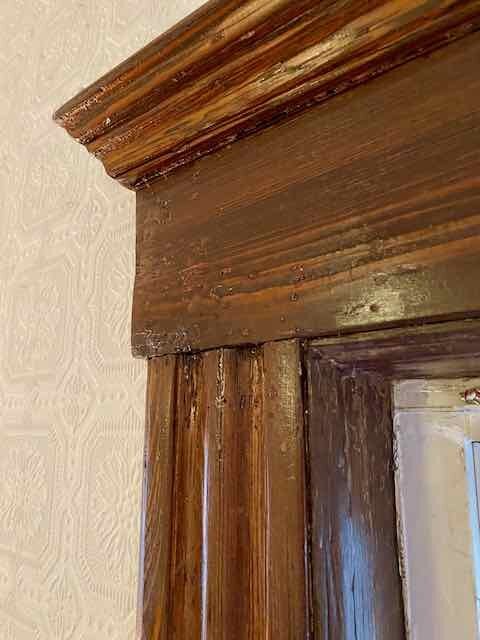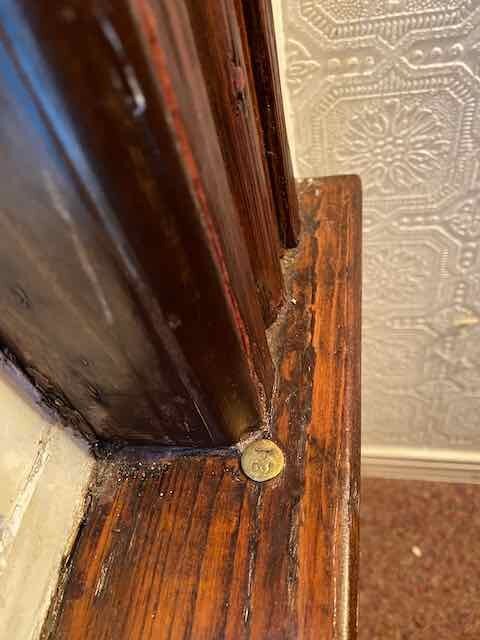Restoring Wood Molding on the West Side
September 02, 2021
By Ed Stone French
In Hudson County, we are lucky to have a wide variety of home styles spanning over 100 years. Some of our most beautiful homes are Victorian-era properties, many with distinct details like stained glass windows, stately molding and wainscoting, hardwood floors with intricate inlays, and some have impressive turrets and gabled roofs.
Our home in the West Side neighborhood of Jersey City was built in 1901 and underneath layers of paint and handyman fixes, the details of a Victorian-era house can be uncovered. We knew that many of the moldings in our house were original and dated back to the early 20th century.
Ours was surely once a stately house with Victorian elegance. But layer upon layer upon layer upon layer of paint had been laid upon the original wood underneath. Parts of the paint had been scraped off and punctured. There were holes and gouges in the wood. So we could see that a nice wooden texture existed below the paint.
Enter John Keen. John is a jack-of-all-trades and “kind of a carpenter” (his description) with a keen sense of how to restore old details. With the goal of restoring our molding to its original grandeur, he worked with a Swedish-made infrared ‘heat gun’ called a Speed Heater which, through slow and methodical use, can soften the paint enough to remove those layers of paint from the wood without releasing toxic fumes. Earlier technology was problematic due to the release of toxic fumes. John also knew of a famous incident when a historic home had burned down starting with a spark from such technology. While precautions were still necessary, due to the infrared heating, it’s much safer to use.
The Speed Heater also comes with hand tools designed specifically for pulling paint and scraping it from wood. “The tools were virtually as important as the heat gun itself,” John added.
Preparing to do this work is no small task by itself. Rooms had to be emptied, furniture and flooring covered with plastic. Windows had to be opened, which was frosty given that we did the work in December. John had to wear protective clothing and breathe through a mask. We were worried about any sort of contaminant, including the high chance of lead-based paint.
John informed me thanks to a course in lead-based paint abatement he had taken, “Any house from this era is likely to have lead based paint, and these precautions are for safely doing this work. I was working in a carpeted child’s bedroom and I wanted to make sure it was absolutely secure.”
He also added, “You must have a respirator rated for this. A surgical mask isn’t good enough.”Luckily, we were out of town over the week that John did the work.
“There’s no overstating what meticulous drudgery it is to dig out all the stuff from all of the nooks and crannies,” he explained. “It’s like cleaning the beach with a pair of tweezers. It’s worth it in the end, but it’s drudgery and tedium. However, the infrared gun makes it much easier and safer than household chemical cleaners and paint strippers.”
John’s most positive impression was that “Even though it wasn’t my house, it was interesting to see it like an archeological dig and discover the craftsmanship of the house underneath. It’s worth the effort. It feels like digging down to the beginnings of our own civilization in America.”
He then sanded and treated the wood. Sanding was also quite a process as he meticulously went over every detail of the wood, healing the rough spots and filling the biggest gouges. But the original beauty and grain of the wood eventually shined through.
“In certain spots, I was able to get the original look of the wood and the window in 1910 without any staining or refinishing. It was very uneven though; it still had to be stained and refinished to get the original look on the whole of the window molding.Getting it sanded down to the bare wood was interesting. Lots of details articulated and refined.” He speculates that it’s made of oak.
He had to use a wire brush on a lot of it because sandpaper couldn’t get into all the grooves and crevices. Some of the woodwork was damaged in the process, but it was impossible to avoid a little bit of damage. After spending days testing and considering various treatments, we settled on a darker stain. We narrowed it to three different stains and eventually my wife and I chose the darkest one, even though John preferred a lighter stain.
There are still several windows and doors to restore in our home. John believes the doors will be easier. Even though the door molding has more surface area, there aren’t as many intricate details, which is what really takes time. It’s a labor-intensive process and more pressing needs have arisen in our house, so getting all of the restorations finished must wait. Our goal is to eventually restore all the original molding and find replacement molding for all the unmatched molding that was placed in our home previously.
Since becoming a realtor in Hudson County, I’ve seen similar molding in many houses. It must have been very popular at the time.
It excites me to think about all the possible restoration work that can be done in the historic houses in the area and I hope this inspires more people to do this work.
Do you have any experience with original molding in houses in the area? If so, please let us know!




